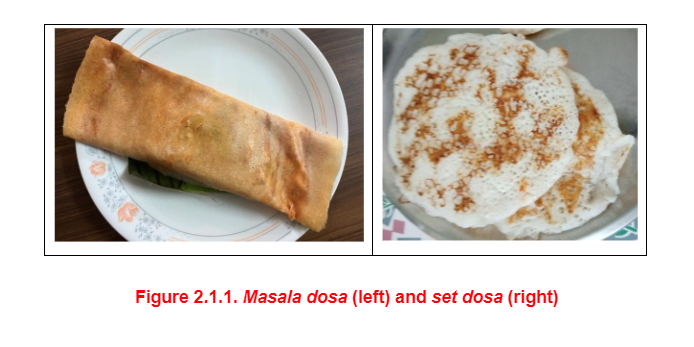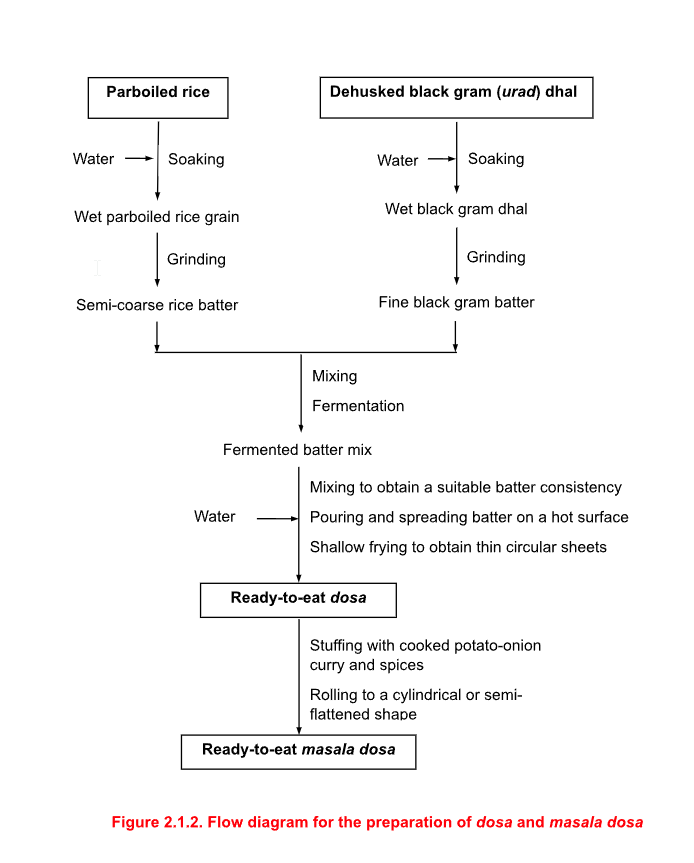Traditional Food of India
2.1.Dosa
Dosa (also called dosha and dose) is a ready-to-eat Indian rice pancake made usually from a fermented batter of a mixture of rice and black gram (Figure 2.1.1). It is a traditional product from South India that is typically served in a warm condition along with chutney (thick paste prepared using roasted chickpea flour) or sambar (pulse-based slurry with a souring agent and spices). The product is now sold throughout India in restaurants, and counters of snack bars and fast food chains. Dosa is primarily consumed as a breakfast food though taken during lunch, dinner and afternoon tea.
Raw materials
The main ingredients are rice and black gram while optional ingredients are salt, sodium bicarbonate, spices like chilli and fenugreek, millet/cereal flour like ragi (finger millet), bajra (pearl millet), jowar (sorghum) and wheat, and pulse flours like red gram, lentil and chana (chickpea). In the case of masala dosa, cooked potato and onion pieces, and spices like chilli, turmeric, etc are added to make the product attractive to consumers and increasing the bulk volume.

Method of preparation
Rice flour can be prepared from the kernels of steamed or parboiled rice but is generally made from broken rice as a cost-reduction strategy. The process employed for size reduction is dry, wet or semi-wet grinding of which wet grinding (after adding water) is conventionally practiced. The wet grinding process has the advantage of reduced starch damage as the presence of water helps in lubrication and restricts temperature rise during grinding. The decorticated black gram dhal is also subjected to a wet-grinding process separately after which it is mixed with rice batter.
Wet ground parboiled rice and black gram (2:1-5:1) batter mix is subjected to auto fermentation at room temperature for 6-12 h (Figure 2.1.2). The batter increases in its volume and is later mixed to a just-flowable consistency. The batter is then carefully spread as a circular thin sheet on a flat hot oil-smeared surface and subjected to shallow frying. The rice batter contains coarse ground rice particulates possibly due to difficulty during the wet-grinding of hard parboiled rice. On the other hand, black gram is wet-ground to a smooth batter having finer particle sizes. The obtained thickness of product varies from 2 mm (thin sample having crisp texture) to 10 mm (thick sample having semi-soft texture); diameter usually varies from 200 mm to 300 mm though bigger than this size is also prepared. The prepared product is often folded or rolled to a cylindrical hollow shape for convenience of serving. Other cereal flours like ragi, maize, and wheat are also used to make dosa pancakes. On some occasions, buttermilk, baking powder, and salt are added. Sometimes, a thin moist pancake is shallow-fried on both sides and filled with jam, chocolates, nut pieces, cheese cream and chocolate, and the taste of the finished product may be sweet or savoury.
The ingredients of dosa are similar to idli but dosa is like a pancake that is shallow-fried in oil and not steamed as for idli. Instant dosa mix, as a dry powder, is available on shelves that do not need to undergo the fermentation process, but the remaining preparation process of slurry making and shallow frying are required. Dosa mix has a shelf-life of 6 months or more. Further, wet batters of dosa, stored in refrigerated conditions, are also commercially available which also do not require any fermentation process.
Varieties of dosa
The most popular among dosas is masala dosa (also called masale dose) which contains a semi-dry potato-onion curry. The other different varieties of dosa are rava (rawa) dosa (prepared using fine wheat semolina), ragi (finger millet dosa (prepared using ragi flour along with a small quantity of wheat flour), and onion dosa (prepared using added small pieces of onion). Mysore masala dosa is a crisp and soft dosa spiced with red chutney and served with a potato dish, along with coconut chutney. Another attractive dosa is paper dosa which is usually crisp and thin. On some occasions, extra long paper dosa of length 600-1000 mm is also prepared for special consumer attractions in restaurants, dosa shops and snack bar counters. The product set dosa (Figure 2.1.1) is thick (8-15 mm in thickness) and possesses a soft chewy texture. The product is often consumed during lunch and dinner apart from its conventional use as a breakfast food.

Technical data
- The presence of an arabinogalactan type of polysaccharide has been reported to offer a high viscosity of the batter in addition to forming a cohesive batter system. The rice-black gram batter mix contains 58-62% moisture content.
- The rheological status of dosa batter is available. The batter is non-Newtonian shear-thinning in behaviour and possesses yield stress.
Machinery
The requirements are wet grinding batch units, batter mixing devices, batter dispensing and spreading gadgets/machines, and batch/continuous shallow frying systems.
Requirements
- The fat content in dosa is 5 to 10%; some varieties may also have higher fat content. Thus, it cannot be termed a low-fat product. It is thus desirable to formulate low-fat-containing dosas.
- Dosas have a shelf-life of only a few hours. There is a need to increase the shelf-life of dosas so that industrial production is possible and benefits the consumers.
- Frozen and refrigerated dosas may be attempted that can be consumed simply by warming or microwaving.
Further reading
Bhattacharya, K.R. and Ali, S.Z. (2015). An introduction to rice-grain technology. Woodhead Publishing India Pvt. Ltd (CRC Press), New Delhi, India, pp 186-188.
Bhattacharya, S., Baby Latha, R. and Bhat, K.K. (2004). Controlled stress rheological measurement of blackgram flour dispersions. Journal of Food Engineering 63, 135–139.
Bhattacharya, S. and Bhat, K.K. (1997). Steady shear rheology of rice-blackgram suspensions and suitability of rheological models. Journal of Food Engineering 32, 241-250.
Rati Rao, E., Vijayendra, S.V.N.and Varadaraj, M.C. (2006). Fermentation biotechnology of traditional foods of the Indian subcontinent. Chapter 3.18. In: Food biotechnology, 2nd edition. Edited by Kalidas Shetty, Gopinadhan Paliyath, Anthony Pometto and Robert E. Levin. Taylor and Francis, Boca Raton, USA.
Soni, S.K., Sandhu, D.K., Vilkhu, K.S. and Kamra, N. (1986). Microbiological studies on Dosa fermentation. Food Microbiology 3, 45-53.
Tamang, J. P., Thapa N., Bhalla, T.C. and Savitri (2016). Ethnic fermented foods and alcoholic beverages of India. Chapter 2. In: Ethnic fermented foods and alcoholic beverages of Asia. Edited by Jyoti Prakash Tamang, Springer India, pp. 17-72.
Websites
